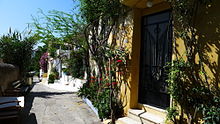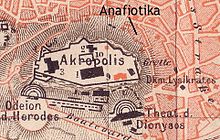Anafiotics
Anafiotika ( Greek Αναφιώτικα ( n. Pl. )) Is a small district of Athens , on the northeast slope of the Acropolis on the edge of the historic Plaka . It was built by builders from the Cyclades, mainly from Anafi Island , in the mid-19th century . The quarter is built in the style of a Cycladic village with staggered, asymmetrical, whitewashed terrace roof houses, walled gardens and partly marble-paved or whitewashed small paths.
history
After the seat of government was relocated from Nafplio to Athens under King Otto in 1834, the new capital experienced intensive construction activity. As early as 1833, the architects Kleanthis and Schaubert had drawn up a plan for urban development in Athens. The new development was only structurally connected to the Plaka, large areas (such as the Kerameikos ) remained free to enable later archaeological excavations.
At the difficult-to-reach, steep foot of the Acropolis, an area unsuitable for the development of a residential area, families of craftsmen from the Cyclades settled, mostly from the island of Anafi. In an area that was already settled during the Neolithic Age, the residential district Anafiotika was built based on the architectural model of the island villages by the end of the 19th century. The settlement was tolerated, but no building permit was granted.
The population composition changed after 1922 due to the influx of refugees from Asia Minor , who had to leave their homeland as a result of the Greco-Turkish War in accordance with the contractually regulated population exchange .
In 1970 the owners of 75 of the 84 houses were expropriated due to archaeological concerns. The remaining 9 are around the church of Agios Simeon . To rebuild the Peripatos , an old footpath along the Acropolis, 27 houses were demolished.
Settlement and social life
The settlement was built as an informal settlement in an era of great housing shortages and is tacitly tolerated by the authorities. Since the middle of the last century there has been no legal claim to property or right of residence. Repeated attempts by the authorities to demolish the settlement and to rebuild it have so far not been successful, not only because of the expected protests by the residents, but also by numerous citizens of the city, with whom this picturesque quarter is particularly valued and as endearing historical district.
With its narrow, stepped, very narrow and shadowy alleys, including winding dead ends, low houses in cubic construction and whitewashed walls, many of which are surrounded by flowering bushes, lush flower pots and colorful doors, the Anafiotika settlement looks like a Greek island village in the Cyclades . The houses are staggered on the slope, none of them obstruct the view of the other. Today there are only about 45 intact houses, whereby the small streets of the settlement have no names and the houses are numbered as "Anafiotika 1", "Anafiotika 2" etc. For visitors, the Anafiotika settlement is something unique, it looks like "An island on dry land - a Cycladic village in the middle of Athens".
The residential density in the settlement is very high. The residents maintain a village-like coexistence and fight for the preservation of their settlement and their right to live in one of the oldest quarters of Athens, which in their opinion should also be subject to monument protection.
In 2009, the Architecture School / National Technical University of Athens started a student project on the anafiotics with the aim of exploring and making understandable minimal architecture of the city of Athens in this quarter, describing its formation in the everyday life of its residents and describing perspectives for a future of To show anafiotics.
Attractions
Anafiotics have gained significantly in importance as a tourist attraction. The Anafiotika include three small churches, which, like the houses of the settlement, were built in the Cycladic style. On the western edge is the single-nave basilica of Agios Simeon from the 17th century with an impressive apse choir and barrel vault , at the other end is the church of Agios Giorgos tou Vrachou (resting on the rock), which dates from the 13th to the 13th 17th century.
See also
literature
- Roxane Kaftantzoglou: The shadow of the Sacred Rock: Contrasting discourses of place under the Acropolis . In: Barbara Bender, Margot Winer (Ed.): Contested landscapes: movement, exile and place . Berg Verlag, 2001, p. 21–36 ( limited preview in Google Book search).
- Inka Schmeling: The forbidden village of Anafiotika . In: Manfred Bissinger (Ed.): Book 4 Merian Athens . Merian Verlag, 2004, p. 78-81 .
- Μιχάλης Δωρής (Michalis Doris): Πλάκα - Αναφιώτικα, Αυτοδιοίκηση και Αυτοδιαχείρηση της περιοχής . In: Άνθρωπος + Χώρος, Ελληνικό αρχιτεκτονικό περιοδικό . No. 3 , 1977. Online (Greek)
Web links
- Αναφιώτικα, Αρχαιολογία της Πόλης των Αθηνών (Greek)
- ΕΔΩ ΓΕΝΝΗΘΗΚΕ Η ΕΥΡΩΠΗ - ΤΑ ΑΝΑΦΙΩΤΙΚΑ - historical film recordings of the anafiotics (28 min) (Greek)
- ΤΑ ΑΝΑΦΙΩΤΙΚΑ - Historical photo of the anafiotics (Greek)
Individual evidence
- ↑ Greek Ministry of Culture and Tourism (Greek; PDF; 750 kB)
- ↑ Architecture School / National Technical University of Athens (Greek / English)
Coordinates: 37 ° 58 ' N , 23 ° 44' E



